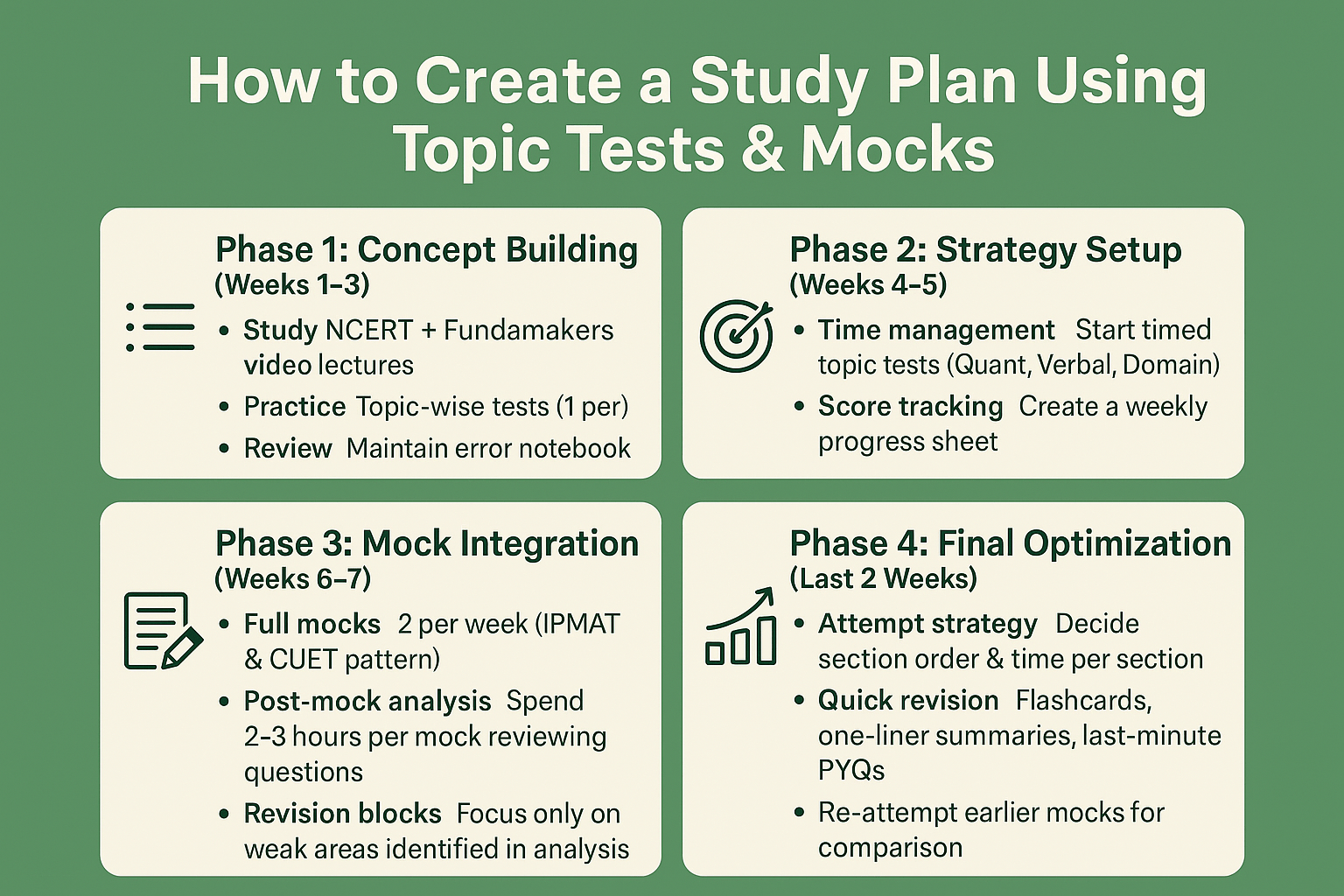Creating a study plan is easy.
Sticking to it is hard.
Making it work? That’s strategy.
If you’re preparing for CUET or IPMAT, a generic plan won’t help. What you need is a performance-based study planner—one that adapts to how you’re doing in topic tests and mock exams.
This blog will help you build a real-world study strategy using analytics, mocks, and time blocks that actually work.
Why You Should Use Mocks & Topic Tests to Build Your Study Plan
Most students treat mock tests as a final lap activity. That’s a mistake.
Mocks and topic tests should guide your entire preparation timeline.
Here’s why:
- They tell you what topics need more revision
- They help you spot time-consuming chapters
- They show how you react under pressure
- They help you convert knowledge into marks
If you’re just reading books without testing, you’re preparing blindfolded.

Study Plan for IPMAT & CUET: Building It the Smart Way
Here’s a 4-phase adaptive study planner using topic tests + mock analytics:
Phase 1: Concept Building (Weeks 1–3)
| Focus | What to Do |
| Core topics | Study NCERT + Fundamakers video lectures |
| Practice | Topic-wise tests (1 per day) |
| Review | Maintain an error notebook |
Tools:
Phase 2: Strategy Setup (Weeks 4–5)
| Focus | What to Do |
| Time management | Start timed topic tests (Quant, Verbal, Domain) |
| Score tracking | Create a weekly progress sheet |
| Weak area mapping | Identify low accuracy chapters from mocks |
Pro Tip:
Tag your mocks by difficulty (easy/medium/hard) & analyze where your time-to-score ratio is lowest.
Phase 3: Mock Integration (Weeks 6–7)
| Focus | What to Do |
| Full mocks | 2 per week (IPMAT & CUET pattern) |
| Post-mock analysis | Spend 2–3 hours per mock reviewing questions |
| Revision blocks | Focus only on weak areas identified in analysis |
Resources:
Phase 4: Final Optimization (Last 2 Weeks)
| Focus | What to Do |
| Attempt strategy | Decide section order & time per section |
| Quick revision | Flashcards, one-liner summaries, last-minute PYQs |
| Confidence building | Re-attempt earlier mocks for comparison |
How to Use Mocks Strategically
A good mock test is more than just a score. Here’s how to get the most out of each one:
- Don’t skip analysis. Spend more time reviewing than writing.
- Ask the right questions:
Was my mistake conceptual or careless?
Did I run out of time in a particular section?
Did I guess too many answers?
Use “error tagging”: Build a tracker by topic → see patterns in weak areas.
Example: Real Mock-to-Plan Conversion
Let’s say you took a full mock and scored:
| Section | Score | Accuracy | Time Taken |
| Quant (IPMAT) | 24/40 | 60% | 45 mins |
| Verbal (CUET) | 38/50 | 90% | 35 mins |
| Business Studies | 32/40 | 80% | 40 mins |
Action Plan:
- Quant: Revisit Number System + Time & Work
- Verbal: Maintain with light daily practice
- Business: Improve speed—practice case-based MCQs
CUET & IPMAT Test Strategy Tips
- Set Sunday = Mock Day
- Give one sectional test daily
- Keep a weekly “analytics hour” to update your plan
- Don’t study everything every day—focus on 2–3 topics per block
- Use colors in your planner:
🔴 = Weak
🟡 = Average
🟢 = Strong
Free Tools You Can Use (from FundaMakers)
- Mock Test Dashboard
- Topic-Wise Performance Graphs
- Weekly Study Timetables
- Score Analyzer & Rank Predictor
- Mentor Calls after Every Mock
Access the Full Study Planner Tools
A good study plan doesn’t just say “what to study.” It tells you when, how, and why.
The smartest students don’t just work hard—they test early, revise based on feedback, and improve week by week.
With FundaMakers’ test series and analytics tools, your study plan becomes a roadmap—not a guess.
Ready to Build Your Smart Study Plan?
Join FundaMakers CUET & IPMAT Test Series
Turn every mock into a milestone.
FAQs: IPMAT & CUET Study Planning with Mocks
1. Why should I use topic tests in my study plan?
Topic tests help you evaluate your understanding of a concept in isolation. They are perfect for identifying weak spots early and reinforcing accuracy through repetition.
2. When should I start giving mock tests for CUET or IPMAT?
Ideally, begin full mock tests once you’ve covered 60–70% of the syllabus. However, sectional and topic-wise mocks can be taken from the first month to build familiarity.
3. How many mock tests should I take before the actual exam?
We recommend at least 15–20 full-length mocks and 40+ topic-wise/sectional tests to ensure readiness. FundaMakers’ test series is structured to support this flow.
4. How do I analyze mock tests effectively?
Don’t just look at your score. Analyze:
- Time taken per section
- Accuracy percentage
- Types of errors (conceptual vs silly mistakes)
- Topics with low consistency
- Use this data to revise and adjust your study plan weekly.
5. How do I build a CUET or IPMAT study plan from scratch?
Start by dividing your time into:
- Concept learning
- Topic-wise testing
- Mock exams
- Analysis and revision
Use a 4-phase structure:
Concept Building → Strategy Setup → Mock Integration → Final Optimization.
6. Should I study all subjects every day?
No. Use time blocks. Focus on 2–3 subjects or topics per day for better depth and retention. Rotate subjects every 2–3 days depending on your test schedule.
7. What if I score low in mocks? Should I stop?
Absolutely not. Low mock scores are insights, not failures. Use them to adjust your strategy. With proper analysis and mentor support, your scores will improve steadily.
8. Where can I find CUET and IPMAT topic-wise and full mock tests?
You can access FundaMakers’ structured test series, mock analytics, and personalized feedback here:
FundaMakers CUET & IPMAT Test Series
Read more : https://fundamakers.com/ipmat-vs-cuet-which-exam-is-right-for-you/



